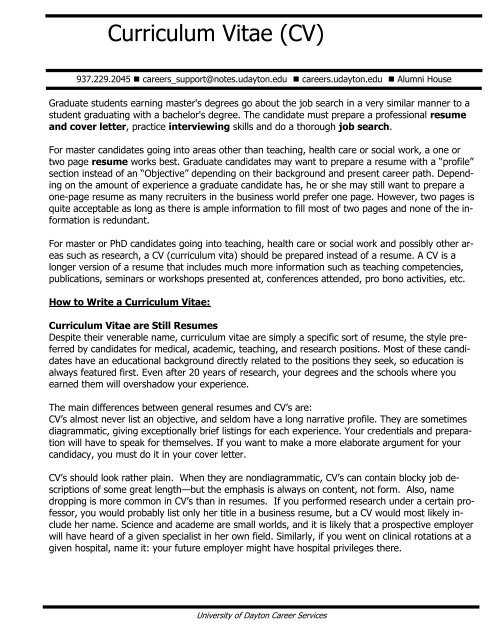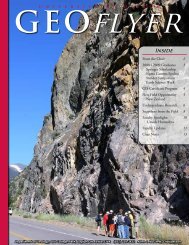Curriculum Vitae (CV) - University of Dayton
Curriculum Vitae (CV) - University of Dayton
Curriculum Vitae (CV) - University of Dayton
You also want an ePaper? Increase the reach of your titles
YUMPU automatically turns print PDFs into web optimized ePapers that Google loves.
<strong>Curriculum</strong> <strong>Vitae</strong> (<strong>CV</strong>)<br />
937.229.2045 • careers_support@notes.udayton.edu • careers.udayton.edu • Alumni House<br />
Graduate students earning master's degrees go about the job search in a very similar manner to a<br />
student graduating with a bachelor's degree. The candidate must prepare a pr<strong>of</strong>essional resume<br />
and cover letter, practice interviewing skills and do a thorough job search.<br />
For master candidates going into areas other than teaching, health care or social work, a one or<br />
two page resume works best. Graduate candidates may want to prepare a resume with a “pr<strong>of</strong>ile”<br />
section instead <strong>of</strong> an “Objective” depending on their background and present career path. Depending<br />
on the amount <strong>of</strong> experience a graduate candidate has, he or she may still want to prepare a<br />
one-page resume as many recruiters in the business world prefer one page. However, two pages is<br />
quite acceptable as long as there is ample information to fill most <strong>of</strong> two pages and none <strong>of</strong> the information<br />
is redundant.<br />
For master or PhD candidates going into teaching, health care or social work and possibly other areas<br />
such as research, a <strong>CV</strong> (curriculum vita) should be prepared instead <strong>of</strong> a resume. A <strong>CV</strong> is a<br />
longer version <strong>of</strong> a resume that includes much more information such as teaching competencies,<br />
publications, seminars or workshops presented at, conferences attended, pro bono activities, etc.<br />
How to Write a <strong>Curriculum</strong> <strong>Vitae</strong>:<br />
<strong>Curriculum</strong> <strong>Vitae</strong> are Still Resumes<br />
Despite their venerable name, curriculum vitae are simply a specific sort <strong>of</strong> resume, the style preferred<br />
by candidates for medical, academic, teaching, and research positions. Most <strong>of</strong> these candidates<br />
have an educational background directly related to the positions they seek, so education is<br />
always featured first. Even after 20 years <strong>of</strong> research, your degrees and the schools where you<br />
earned them will overshadow your experience.<br />
The main differences between general resumes and <strong>CV</strong>’s are:<br />
<strong>CV</strong>’s almost never list an objective, and seldom have a long narrative pr<strong>of</strong>ile. They are sometimes<br />
diagrammatic, giving exceptionally brief listings for each experience. Your credentials and preparation<br />
will have to speak for themselves. If you want to make a more elaborate argument for your<br />
candidacy, you must do it in your cover letter.<br />
<strong>CV</strong>’s should look rather plain. When they are nondiagrammatic, <strong>CV</strong>’s can contain blocky job descriptions<br />
<strong>of</strong> some great length—but the emphasis is always on content, not form. Also, name<br />
dropping is more common in <strong>CV</strong>’s than in resumes. If you performed research under a certain pr<strong>of</strong>essor,<br />
you would probably list only her title in a business resume, but a <strong>CV</strong> would most likely include<br />
her name. Science and academe are small worlds, and it is likely that a prospective employer<br />
will have heard <strong>of</strong> a given specialist in her own field. Similarly, if you went on clinical rotations at a<br />
given hospital, name it: your future employer might have hospital privileges there.<br />
<strong>University</strong> <strong>of</strong> <strong>Dayton</strong> Career Services
Unlike resumes, <strong>CV</strong>’s can run on for pages and pages. They should, however, be very neatly organized,<br />
with clear headings and distinct conceptual division, so that they can be skimmed as easily as<br />
a two-page resume.<br />
In addition to the usual catalog <strong>of</strong> degrees and job histories, <strong>CV</strong>’s <strong>of</strong>ten contain many more categories<br />
<strong>of</strong> information. Experience may be divided between headings for TEACHING and RESEARCH;<br />
education may be divided between DEGREES and CONTINUING EDUCATION or ADVANCED TRAIN-<br />
ING; publications may be divided into subcategories <strong>of</strong> BOOKS, ARTICLES, CONFERENCE PRESEN-<br />
TATIONS, ABSTRACTS, BOOK REVIEWS, and UNPUBLISHED PAPERS. How you organize this material<br />
determines its impact on your reader.<br />
Scour Your Background for Evidence to Present<br />
As with technical resumes, employers get clues about your intelligence and focus from the way you<br />
organize and present your <strong>CV</strong> data. Your presentation will be judged largely on the number and nature<br />
<strong>of</strong> listings. Material that you may think <strong>of</strong> as irrelevant may end up clinching your presentation.<br />
If you gave fourteen lectures in the last year, don’t say, “but that’s obvious”—list them! Make them<br />
interesting!<br />
When you have published dozens <strong>of</strong> books and journal articles you can afford to skip the obvious;<br />
when you are fresh out <strong>of</strong> school it is better to let the search committee know exactly what you<br />
have done and, by inference, what you can do. For example, citing your doctorate in nonverbal<br />
communication establishes your basic credentials, but listing lectures like the following is a much<br />
more effective way to give the search committee a feeling for who you are as a person and an intellectual:<br />
Outside Lectures & Courses<br />
Portland Bar Association<br />
“The Total Argument”<br />
“Choosing Jurors: Consider the Nonverbal Evidence”<br />
“Nonverbal Communication in the courtroom: Whose Side Are You on, anyway?”<br />
“The Defense Attorney and Nonverbal Communication”<br />
“Prepping Your Client for Courtroom Appearances: You Never Get a Second Chance…”<br />
<strong>University</strong> <strong>of</strong> California, Long Beach<br />
Department <strong>of</strong> Industrial Design<br />
“Proxemics”<br />
“Use <strong>of</strong> Space to Communicate”<br />
<strong>University</strong> <strong>of</strong> California, Berkeley<br />
School <strong>of</strong> Architecture<br />
“Space and Power in Corporate America”<br />
<strong>University</strong> <strong>of</strong> California, Los Angeles<br />
Film School/Broadcast Communication Arts (joint presentation)<br />
“Nonverbal Communication in Film and Television: Mastering the Total Message”<br />
<strong>University</strong> <strong>of</strong> <strong>Dayton</strong> Career Services
As with any other resume, review your total universe <strong>of</strong> material before deciding what to<br />
include, what to feature, and what to omit. Review all potential data in the following categories:<br />
Degrees Study abroad Volunteer Experience Appointments<br />
Dissertations Teaching Service Consulting<br />
These Workshops Languages Practica<br />
Pro bono Clinics Laboratory skills Activities<br />
Continuing Ed. Seminars Technical skills Sports<br />
Training Conferences Computer skills Travel<br />
Specialization Symposia Licenses Bibliography<br />
Expertise Publications Credentials Addenda<br />
Pr<strong>of</strong>ession Translations Honors Assistantships<br />
Interests Presentations Scholarships Keywords<br />
Employment Papers Fellowships Lectures<br />
Research Exhibitions Grants Committees<br />
Additional Academic/service/ Honorary/pr<strong>of</strong>essional/ All other college<br />
Class projects Performance awards Social affiliations Studies<br />
After compiling this raw data, present your background in the most compelling order and format for<br />
your targeted reader.<br />
One last note: Bibliographies longer than two pages, or any other category with more than two pages<br />
<strong>of</strong> information, should be separated out from the main bode <strong>of</strong> the <strong>CV</strong>. Of course, different disciplines<br />
have different protocols for bibliographic data and you will need to learn and follow those for<br />
your pr<strong>of</strong>ession. Bibliographies used to be assembled in chronological order, so that the author<br />
could add new data to the bottom with a typewriter, but with the advent <strong>of</strong> computers, bibliographies<br />
should run in reverse chronological order like everything else (as a general rule).<br />
<strong>University</strong> <strong>of</strong> <strong>Dayton</strong> Career Services
OBJECTIVE:<br />
Assistant Pr<strong>of</strong>essor, Educational Psychology<br />
Sally S. Student<br />
Office: Hall 1111, School <strong>of</strong> Education<br />
<strong>University</strong> <strong>of</strong> <strong>Dayton</strong>, <strong>Dayton</strong>, OH 45409<br />
(937) 229-0000 Studentsal@udayton.edu<br />
Home: 5555 Main Street, <strong>Dayton</strong>, OH 45449<br />
(937) 229-9999<br />
ACADEMIC PREPARATION:<br />
Ph.D. in Education, School <strong>of</strong> Education, <strong>University</strong> <strong>of</strong> <strong>Dayton</strong>, <strong>Dayton</strong>, OH, May 2008<br />
Concentrations: Educational Psychology<br />
Dissertation: A Study <strong>of</strong> Topic Advisor: Dr. Don Donaldson<br />
M.A. in Education, Faculty in Education, <strong>University</strong> <strong>of</strong> <strong>Dayton</strong>, <strong>Dayton</strong>, OH, May 2005<br />
Concentrations: Educational Psychology, Language Development and Reading<br />
Thesis: Your Topic<br />
Advisor: Dr. James Jameson<br />
B.A. in Psychology, <strong>University</strong> <strong>of</strong> <strong>Dayton</strong>, <strong>Dayton</strong>, OH, December 2003<br />
Concentrations: Learning Theory, Psycholinguistics<br />
RESEARCH SKILLS:<br />
- Utilized SPSS and SAS statistical programs extensively<br />
- Survey and evaluation research techniques<br />
LANGUAGES:<br />
- Fluent in English and French<br />
- Can read some German and Spanish<br />
PROFESSIONAL EXPERIENCE:<br />
Supervisor <strong>of</strong> Teacher Education,2007-present<br />
School <strong>of</strong> Education, <strong>University</strong> <strong>of</strong> <strong>Dayton</strong>, <strong>Dayton</strong>, OH<br />
-Supervised student teachers and interns working on multiple-subjects and special education<br />
teaching credentials<br />
Instructor, Summer Sessions, 2006-2007<br />
School <strong>of</strong> Education, <strong>University</strong> <strong>of</strong> <strong>Dayton</strong>, <strong>Dayton</strong>, OH<br />
Course: The Exceptional Child<br />
Teaching Assistant , Spring 2006<br />
Faculty in Education, <strong>University</strong> <strong>of</strong> <strong>Dayton</strong> Graduate School, <strong>Dayton</strong>, OH<br />
Courses: Advanced Statistics, Introduction to Learning Disabilities<br />
Teaching Assistant , Spring 2006<br />
Faculty in Education, <strong>University</strong> <strong>of</strong> <strong>Dayton</strong> Graduate School, <strong>Dayton</strong>, OH<br />
Courses: Tests and Measurement, Casework in Educational Psychology<br />
Research Assistant , Fall 2004<br />
Faculty in Education, <strong>University</strong> <strong>of</strong> <strong>Dayton</strong> Graduate School, <strong>Dayton</strong>, OH<br />
- Assisted Dr. Mary Mason on the Educational Psychology Project<br />
- Collected and analyzed survey data, using the SPSS program<br />
<strong>University</strong> <strong>of</strong> <strong>Dayton</strong> Career Services
Sally S. Student, p. 2<br />
Public School Teacher, 2004-2006<br />
<strong>Dayton</strong> Public Schools, <strong>Dayton</strong>, OH<br />
Educational Psychology, Grades 8 and 12<br />
Peer Counselor, 2003-2004<br />
Developmental Disabilities Immersion Program<br />
<strong>University</strong> <strong>of</strong> <strong>Dayton</strong>, <strong>Dayton</strong>, OH<br />
PUBLICATIONS:<br />
Student, S.S. (2007), Title <strong>of</strong> Article. Magazine, 23(1), 986-989.<br />
Student, S.S. (2006), Title <strong>of</strong> Article. Magazine, 53(1), 17-20.<br />
Student, S.S. (2006), Book review <strong>of</strong> Title <strong>of</strong> Book (Author, Ed., City, OH: Publisher, 2005) in<br />
Magazine 135(4), April.<br />
RESEARCH SUBMITTED AND IN PREPARATION:<br />
- Title <strong>of</strong> Research<br />
- Title <strong>of</strong> Research<br />
PAPERS PRESENTED AT CONFERENCES:<br />
Title. Presented at the Conference on Educational Psychology, <strong>Dayton</strong>, OH, 2007<br />
Title. Presented at the XXth Annual Conference <strong>of</strong> the Wisconsin State Council for Educational<br />
Psychology, Columbus, OH, 2006<br />
Title. Presented at the XXth Annual Conference <strong>of</strong> the Society for Educational Psychology, Columbus,<br />
OH, 2006<br />
CURRENT RESEARCH INTERESTS:<br />
A survey questionnaire and follow-up interview study <strong>of</strong> parents <strong>of</strong> GATE students to assess<br />
the need for parent support groups<br />
GRANTS RECEIVED:<br />
Ohio State Teacher Grant A Title. Awarded October 2007<br />
PROFESSIONAL MEMBERSHIPS:<br />
American Educational Research Association<br />
Midwest Consortium on Innovation in Teaching<br />
Society for Educational Psychology<br />
PROFESSIONAL SERVICE:<br />
- Vice President, Midwest Consortium on Innovation in Teaching, 2007<br />
- Chair, <strong>University</strong> Relations Committee, Society for Educational Psychology, 2005-2006<br />
<strong>University</strong> <strong>of</strong> <strong>Dayton</strong> Career Services
Sally S. Student, p. 3<br />
HONORS AND AWARDS:<br />
Scholarship Award, <strong>Dayton</strong>, OH, 2007<br />
Outstanding Dissertation Award, <strong>University</strong> <strong>of</strong> <strong>Dayton</strong>, <strong>Dayton</strong>, OH, 2006<br />
REFERENCES:<br />
Don Donaldson, Pr<strong>of</strong>essor<br />
School <strong>of</strong> Education<br />
<strong>University</strong> <strong>of</strong> <strong>Dayton</strong>, <strong>Dayton</strong>, OH<br />
(937) 229-1111<br />
Don.Donaldson@notes.udayton.edu<br />
Pete Petersen, Chair<br />
Department <strong>of</strong> Education<br />
<strong>University</strong> <strong>of</strong> <strong>Dayton</strong>, <strong>Dayton</strong>, OH<br />
(937) 229-9999<br />
Pete.Petersen@notes.udayton.edu<br />
Carol Simpson, Pr<strong>of</strong>essor<br />
Faculty in Education<br />
<strong>University</strong> <strong>of</strong> <strong>Dayton</strong> Graduate School, <strong>Dayton</strong>, OH<br />
(937) 229-0001<br />
Carol.Simpson@notes.udayton.edu<br />
<strong>University</strong> <strong>of</strong> <strong>Dayton</strong> Career Services

















